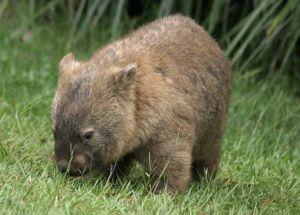Difference between revisions of "Wombat"
| Line 1: | Line 1: | ||
| − | [[Image:Wombat-pic.jpg|right|300px]] | + | [[Image:Wombat-pic.jpg|right|thumb|300px|Wombat]] |
== Scientific Classification == | == Scientific Classification == | ||
Revision as of 01:48, March 22, 2007
Scientific Classification
Kingdom: Animalia Phylum: Chordata Class: Mammalia Infraclass: Marsupialia Order: Diprotodontia Suborder: Vombatiformes Family: Vombatidae
Description
Wombats are stocky, tailless, ursiform marsupials of the Linnaean taxonomic family Vombatidae. They are nocturnal, walk on four short legs, like to burrow, and are herbivorous.
The common wombat (Vombatus ursinus) reaches about three feet in length and produces distinctive cubical scat[1]. There are also two or three (depending on classification) rare species of hairy-nosed wombats of the genus Lasiorhinus[2].
According to creation science theories, after the Flood, representatives of the separately created wombat archaebaramin were among those animals that migrated from the Middle East to Australia as part of the Post-Diluvian Diasporas. There is debate whether this migration happened over land[3] -- as Australia was still for a time connected to Europe by a land bridge similar to the one that connected Asia to America[4] -- or if they rafted on mats of vegetation torn up by the receding flood waters.[3]
Evolutionists theorize that modern wombats evolved from Diprotodontians (the supposed common ancestors of wombats and kangaroos) about 55-65 million years ago and that they are closely related to the koala[1].
One of the most notable features of the wombat is that its pouch opens backwards compared to kangaroos and other marsupial animals. Creation researchers argue that this wombat-specific design provides strong evidence for the wombat's special creation and against the evolutionists' Diprotodontian theory of wombat/kangaroo common ancestry[5].
References
- ↑ 1.0 1.1 Review: The Wombat: Common Wombats in Australia by Barbara Triggs
- ↑ Wombat Information Center: Hairy Nosed Wombat
- ↑ 3.0 3.1 "How did animals get from the Ark to isolated places, such as Australia?", ChristianAnswers.net.
- ↑ "Kangaroos, Dinosaurs, and Eden", Ken Ham.
- ↑ "Watches and Wombats", by Ken Ham, Institute for Creation Research
